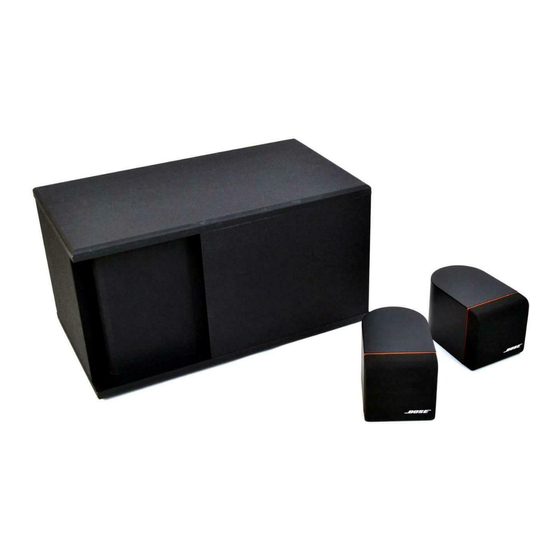Bose Acoustimass 3 Series Manual de servicio - Página 22
Navegue en línea o descargue pdf Manual de servicio para Sistema estéreo Bose Acoustimass 3 Series. Bose Acoustimass 3 Series 42 páginas. Powered speaker system
También para Bose Acoustimass 3 Series: Manual del usuario (17 páginas), Manual del usuario (10 páginas), Manual (43 páginas)

7. Air Leak Test
NOTE: Part A. of this test can be performed with
a fully assembled module.
A. Connect an oscillator to the module's left/right
(L/R) audio input terminals. Adjust the oscillator
to 40 Hz,1 Vrms. Listen for air leaks around the
transformer cup gasket. If there is
a"whooshing"noise,there is probably an air leak
around the gasket. Refer to the Disassembly/
Assembly Procedures section for instructions
on accessing this gasket. Re-position the
transformer cup gasket under the cup to make an
airtight seal.
NOTE: In order to perform the remaining
procedures,it is necessary to disassemble the
module to the woofer level. Leave all connections
intact to perform these tests. Remove the cover
using the procedures in the Disassembly/
Assembly Procedures section. Remove 6
screws which secure the heatsink to the module.
Remove 2 screws which secure the transformer
cup to the module. Slide out the transformer cup
and PCBs carefully. Lay the module on its side to
access the woofer more easily.
B. Using the same oscillator setting as part A.,
listen for air leaks around the woofer gasket. If
there is a "whooshing" noise around the
gasket,re-position the woofer gasket behind the
woofer to make an airtight seal.
8. Woofer Rub and Tick Test
A. Connect an oscillator to the module's L/R
audio input terminals. Adjust the oscillator to 10
Hz,1.5 Vrms. No extraneous noises such as
rubbing,scraping or ticking should be heard.
NOTE: To distinguish between normal
suspension noise and rubs or ticks,displace the
cone on the woofer slightly with your fingers. If
the noise can be made to go away or get worse,it
is a rub or a tick and the woofer should be
replaced. If the noise stays the same,it is normal
suspension noise and the woofer is fine.
Suspension noises will not be heard with
program material.
9. Woofer Phase Test
A. Disconnect the woofer (connector J4) from the
Amplifier PCB. Set a DC power supply to 8
volts. Connect the positive supply lead to the
positive (+) woofer connection (red) and the
negative supply lead to the negative (-) woofer
connection (black). The woofer should move
outwards with the application of the supply
voltage.
10. Frequency Response of Bass Channel
NOTES: Pull the heatsink away from the
Amplifier PCB to expose the board's solder side.
It will be necessary to access the woofer output
connector (J4) to perform the remaining
procedures.
Bass amplifier output measurements are made
across J4 pins 1 and 2. The amplifier uses a
bridged output. Do not connect either output to
ground. Any test equipment that will be
connected to these points must be floated,or
isolated from ground.
A. Make up a temporary set of connections to the
woofer output connector J4.
B. Connect an oscillator to the module's L/R
audio input terminals. Adjust the oscillator to 100
Hz,200 mVrms.
C. Connect a piece of test equipment capable of
measuring decibels to the woofer output
connector J4. Make sure that the meter is not
grounded. Measure the decibels at this setting
and use as a reference for all other readings.
D. Adjust the oscillator frequency and measure
the relative response according to the chart
located at the end of this procedure (next page).
21
